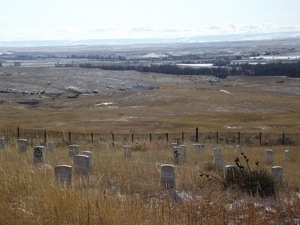Summary | Excerpt | Reading Guide | Reviews | Beyond the Book | Read-Alikes | Genres & Themes | Author Bio

This article relates to The High Divide
Much of Lin Enger's novel, The High Divide, is set in the Montana Territory of the late 1880s. ("The High Divide" is an area of mountain ranges that crosses the Continental Divide between eastern Idaho and western Montana. It includes a small portion of the Badlands.) The Lewis and Clark expedition passed through what is now Montana in 1805-6, and fur traders, missionaries, and explorers set up various outposts over the following decades. The 1860s saw increased settlement due to the discovery of gold deposits.
 President Abraham Lincoln oversaw the establishment of the Montana Territory in May 1864. The land, borrowed from the Idaho and Dakota Territories, was originally acquired through the Louisiana Purchase and the Oregon Treaty. The Bitterroot mountain range formed the new boundary between the Idaho and Montana Territories. Indeed, Montana gets its name from the Spanish word for mountain, montaña.
President Abraham Lincoln oversaw the establishment of the Montana Territory in May 1864. The land, borrowed from the Idaho and Dakota Territories, was originally acquired through the Louisiana Purchase and the Oregon Treaty. The Bitterroot mountain range formed the new boundary between the Idaho and Montana Territories. Indeed, Montana gets its name from the Spanish word for mountain, montaña.
Montana played a minimal role in the Civil War; the fighting never came close. For most of its existence as a territory, it was seen as a land of gold mines and Native American incursions. The Blackfoot Treaty of 1865, signed in Fort Benton, Montana, ceded to the U.S. Government all tribal land west of the Milk River to the Rocky Mountains and south of the Missouri and Teton Rivers. Regrettably, when it came to tribal relations, massacres, reservations, and unequal treaties were the order of the day.
 In 1872 President Ulysses S. Grant created Yellowstone National Park, parts of which are in Montana. A major fire in January 1874 destroyed most of the buildings in Helena, which became the territory's capital that summer. In June 1876, General Custer and his forces were defeated at the Battle of Little Big Horn; there is now a national monument on the site commemorating "Custer's Last Stand." The Northern Pacific Railroad reached Montana territory in the summer of 1883.
In 1872 President Ulysses S. Grant created Yellowstone National Park, parts of which are in Montana. A major fire in January 1874 destroyed most of the buildings in Helena, which became the territory's capital that summer. In June 1876, General Custer and his forces were defeated at the Battle of Little Big Horn; there is now a national monument on the site commemorating "Custer's Last Stand." The Northern Pacific Railroad reached Montana territory in the summer of 1883.
Montana entered the Union as the 41st state on November 8, 1889, just a few years after the events of Enger's novel. Although it is the fourth largest state in area, it is 44th in terms of population and 48th in population density. Its emptiness and natural beauty lend it the nickname, "Big Sky Country," and make it an especially memorable backdrop for The High Divide.
Picture of Miles City, Montana, in 1881 by Frank Jay Haynes
Picture of Little Bighorn Battlefield National Monument: View as must have been seen by Lt. Col. George Armstrong Custer and the remnants of his command. Markers indicating their position when found by General Terry on Last Stand Hill. Position is overlooking Indian encampment site and Little Bighorn River. In the distance are the Bighorn Mountains. Photo taken November 2011 by 1025 wil
Filed under Places, Cultures & Identities
![]() This "beyond the book article" relates to The High Divide. It originally ran in October 2014 and has been updated for the
May 2015 paperback edition.
Go to magazine.
This "beyond the book article" relates to The High Divide. It originally ran in October 2014 and has been updated for the
May 2015 paperback edition.
Go to magazine.
Your guide toexceptional books
BookBrowse seeks out and recommends the best in contemporary fiction and nonfiction—books that not only engage and entertain but also deepen our understanding of ourselves and the world around us.